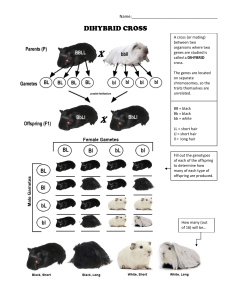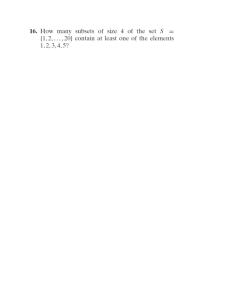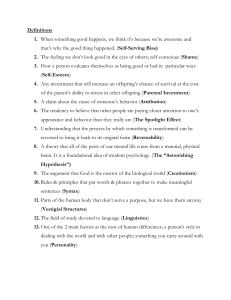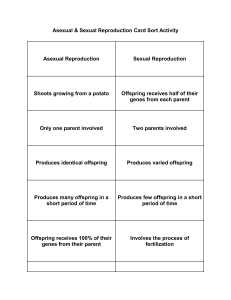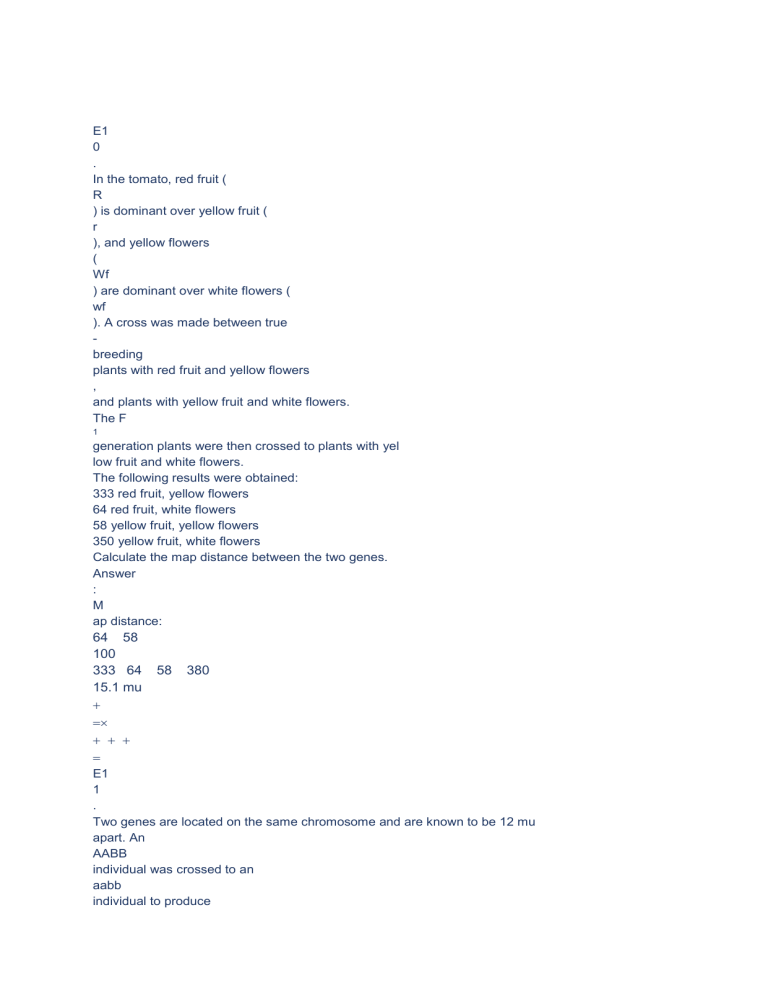
E1 0 . In the tomato, red fruit ( R ) is dominant over yellow fruit ( r ), and yellow flowers ( Wf ) are dominant over white flowers ( wf ). A cross was made between true breeding plants with red fruit and yellow flowers , and plants with yellow fruit and white flowers. The F 1 generation plants were then crossed to plants with yel low fruit and white flowers. The following results were obtained: 333 red fruit, yellow flowers 64 red fruit, white flowers 58 yellow fruit, yellow flowers 350 yellow fruit, white flowers Calculate the map distance between the two genes. Answer : M ap distance: 64 58 100 333 64 15.1 mu 58 380 E1 1 . Two genes are located on the same chromosome and are known to be 12 mu apart. An AABB individual was crossed to an aabb individual to produce AaBb offspring. The AaBb offspring were then crossed to aabb individ uals. A. If this cross produces 1,000 offspring, what are the predicted numbers of offspring with each of the four genotypes: AaBb, Aabb, aaBb, and aabb ? B. What would be the predicted numbers of offspring with these four genotypes if the parental genera tion had been AAbb and aaBB instead of AABB and aabb ? Answer : A. Because they are 12 mu apart, we expect 12% (or 120) recombinant offspring. This would be approximately 60 Aabb and 60 aaBb plus 440 AaBb and 440 aabb. B. We would expect 60 AaBb, 60 aabb, 440 Aabb, and 440 aaBb. E1 2 . Two genes, designated A and B, are located 10 mu from each other. A third gene, designated C, is located 15 mu from B and 5 mu from A. A parental generation consisting of AA bb CC and aa BB cc individuals were crossed to each other. The F 1 heterozygotes were then testcrossed to aa bb cc individuals. If we assume no double crossovers occur in this region, what percentage of offspring would you expect with the following genotypes? A. Aa Bb Cc B. aa Bb Cc C. Aa bb cc Answer : We consider the genes in pairs: there should be 10% offspring due to crossing over between genes A and B , and 5% due to crossing over between A and C. A. This is due to a crossover between B and A. The parentals are Aa bb Cc and aa Bb cc. The 10% recombinan ts are Aa Bb Cc and aa bb cc. If we assume an equal number of both types of recombinants, 5% are Aa Bb Cc. B. This is due to a crossover between A and C. The parentals are Aa bb Cc and aa Bb cc. The 5% recombinants are aa Bb Cc and Aa bb cc. If we assume an equal number of both types of recombinants, 2.5% are aa Bb Cc. C. This is also due to a crossover between A and C. The parentals are Aa bb Cc and aa Bb cc. The 5% recombinants are aa Bb Cc and Aa bb cc. If we assume an equal number of both types of rec ombinants, 2.5% are Aa bb cc. E1 3 . Two genes in tomatoes are 61 mu apart; normal fruit ( F ) is dominant to fasciated fruit ( f ) , and normal numbers of leaves ( Lf ) is dominant to leafy ( lf ). A true breeding plant with normal leaves and fruit was crossed to a leafy plant with fasciated fruit. The F 1 offspring were then crossed to leafy plants with fasciated fruit. If this cross produced 600 offspring, what are the expected numbers of plants in each of the four possible categories: normal leaves, normal fruit; n ormal leaves, fasciated fruit; leafy, normal fruit; and leafy, fasciated fruit? Answer : Due to the large distance between the two genes, they will assort independently even though they are actually on the same chromosome. According to independent assortmen t, we expect 50% parental and 50% recombinant offspring. Therefore, this cross will produce 150 offspring in each of the four phenotypic categories. E1 4 . In the tomato, three genes are linked on the same chromosome. Tall is dominant to dwarf, skin that is smooth is dominant to skin that is peachy, and fruit with a normal tomato shape is dominant to oblate shape. A plant that is true breeding for the dominant traits was crossed to a dwarf plant with peachy skin and oblate fruit. The F 1 plants were then testc rossed to dwarf plants with peachy skin and oblate fruit. The following results were obtained: 151 tall, smooth, normal 33 tall, smooth, oblate 11 tall, peach, oblate 2 tall, peach, normal 155 dwarf, peach, oblate 29 dwarf, peach, normal 12 dwa rf, smooth, normal 0 dwarf, smooth, oblate Construct a genetic map that describes the order of these three genes and the distances between them. Answer : A. One basic strategy to solve this problem is to divide the data up into gene pairs and determine the map distance between two genes. 184 tall, smooth 13 tall, peach 184 dwarf, peach 12 dwarf, smooth 13 12 Map distance 6.4 mu 184 13 184 12 153 tall, normal 44 tall, oblate 155 dwarf, oblate 41 dwarf, normal 44 41 Map distance 21.6 mu 153 44 155 41 163 smooth, normal 33 smo oth, oblate 31 peach, normal 166 peach, oblate 33 31 Map distance 16.3 mu 163 33 31 166 Use the two shortest distances to compute the map: Tall, dwarf 6.4 Smooth, peach 16.3 Normal, oblate E1 5 . A trait in garden peas involves the curling of leaves . A dihybrid cross was made involving a plant with yellow pods and curling leaves to a wild type plant with green pods and normal leaves. All F 1 offspring had green pods and normal leaves. The F 1 plants were then crossed to plants with yellow pods and curl ing leaves. The following results were obtained: 117 green pods, normal leaves 115 yellow pods, curling leaves 78 green pods, curling leaves 80 yellow pods, normal leaves A. Conduct a chi square analysis to determine if these two genes are linked. B. If they are linked, calculate the map distance between the two genes. How accurate do you think this distance is? Answer : A. If we hypothesize the two genes are independently assorting, then the predicted ratio is 1:1:1:1. There are a total of 390 offs pring. The expected number of offspring in each category is about 98. Plugging the figures into our chi square formula, 2 2 2 2 2 2 2 (117 98) (115 98) (78 98) (80 98) 98 98 98 98 3.68 2.95 14.02 4.08 3.31 Looking up this value in the chi square table under 3 degrees of freedom, we reject our hypothesis, because the chi square value is above 7.815. B. Map distance: 78 80 Map distance = 117 115 78 80 40.5 mu Because the value is relatively close to 50 mu, it is probably a significant underestimate of the true distance between these two genes. E1 6 . In mice, the gene that encode s the enzyme inosine triphosphatase is 12 mu from the gene that encodes the enzyme ornithine decarboxylase. Let’s suppose you have identified a strain of mice homo zygous for a defective inosine triphosphatase gene that does not produce any of this enzyme and is also homozygous for a defective ornithine decarboxylase gene. In other words, this strain of mice cannot make either enzyme. You crossed this homozygous recessive strain to a normal strain of mice to produce heterozygotes. The heterozygotes were the n backcrossed to the strain that cannot produce either enzyme. What is the probability of obtaining a mouse that cannot make either enzyme? Answer : In the backcross, the two parental types would be the homozygotes that cannot make either enzyme, and the he terozygotes that can make both enzymes. The recombinants would make one enzyme but not both. Because the two genes are 12 mu apart, 12% would be recombinants and 88% would be parental types. Because there are two parental types are produced in equal number s, we would expect 44% of the mice to be unable to make either enzyme. E1 7 . In the garden pea, several different genes affect pod characteristics. A gene affecting pod color (green is dominant to yellow) is approximately 7 mu away from a gene affecting pod width (wide is dominant to narrow). Both genes are located on chromosome 5. A third gene, located on chromosome 4, affects pod length (long is dominant to short). A true breeding wild type plant (green, wide, long pods) was crossed to a plant with yellow, narrow, short pods. The F 1 offspring were then testcrossed to plants with yellow, narrow, short pods. If the testcross produced 800 offspring, what are the expected numbers of the eight possible phenotypic combinations? Answer : The percentage of recombina nts for the green, yellow and wide, narrow is 7%, or 0.07; there will be 3.5% of the green, narrow and 3.5% of the yellow, wide. The remaining 93% parentals will be 46.5% green, wide and 46.5% yellow, narrow. The third gene assorts independently. There wil l be 50% long and 50% short with respect to each of the other two genes. To calculate the number of offspring out of a total of 800, we multiply 800 by the percentages in each category. (0.465 green, wide)(0.5 long)(800) = 186 green, wide, long (0.465 yell ow, narrow)(0.5 long)(800) = 186 yellow, narrow, long (0.465 green, wide)(0.5 short)(800) = 186 green, wide, short (0.465 yellow, narrow)(0.5 short)(800) = 186 yellow, narrow, short (0.035 green, narrow)(0.5 long)(800) = 14 green, narrow, long (0.035 yello w, wide)(0.5 long)(800) = 14 yellow, wide, long (0.035 green, narrow)(0.5 short)(800) = 14 green, narrow, short (0.035 yellow, wide)(0.5 short)(800) = 14 yellow, wide, short E1 8 . A sex influenced trait is dominant in males and causes bushy tails. The same trait is recessive in females and results in a normal tail . Fur color is not sex influenced. Yellow fur is dominant to white fur. A true breeding female with a bushy tail and yellow fur was crossed to a white male without a bushy tail. The F 1 females were then crossed to white males without bushy tails. The following results were obtained: Males Females 28 normal tails, yellow 102 normal tails, yellow 72 normal tails, white 96 normal tails, white 68 bushy tails, yellow 0 bushy tails, yellow 29 bushy tails, white 0 bushy tails, white A. Conduct a chi square analysis to determine if these two genes are linked. B. If the genes are linked, calculate the map distance between them. Explain which data you used in your calculation. Answer : A. If we rep resent B (bushy tail) and b (normal tail) for one gene, and Y (yellow) and y (white) for the second gene: Parent generation: BBYY bbyy F 1 generation: All BbYy (NOTE: if the two genes are linked, B would be linked to Y and b would be linked to y .) Te stcross: F 1 BbYy bbyy Nonrecombinant offspring from testcross: BbYy and bbyy BbYy males — bushy tails, yellow bbyy males — normal tails, white BbYy females — normal tails, yellow bbyy females — normal tails, white Recombinant offspring from testcross: Bbyy an d bbYy Bbyy males — bushy tails, white bbYy males — normal tails, yellow Bbyy females — normal tails, white bbYy females — normal tails, yellow We cannot use the data regarding female offspring, because we cannot tell if females are recombinant or nonrecombinant, because all females have normal tails. However, we can tell if male offspring are recombinant. If we use the data on males to conduct a chi square analysis, we expect a 1:1:1:1 ratio among the male offspring. Because there are 197 male offspring total, w e expect 1/4, or 49 (rounded to the nearest whole number), of the four possible phenotypes. To compute the chi square: 2 2 2 2 2 2 2 (28 49) (72 49) (68 49) (29 49) 49 49 49 49 9.0 10.8 35.4 7.4 8.2 If we look up the value of 35.4 in our chi square table, with 3 degrees of freedom, the value lies far beyon d the 0.01 probability level. Therefore, it is very unlikely to get such a large deviation if our hypothesis of independent assortment is correct. Therefore, we reject our hypothesis and conclude that the genes are linked. B. To compute map distance: 28 29 100 28.9 mu 28 72 68 29 E 19 . Three recessive traits in garden pea plants are as follows: yellow pods are recessive to green pods, bluish green seedlings are recessive to green seedlings, creeper (a plant that cannot stand up) is recessive to normal. A tru e breeding normal plant with green pods and green seedlings was crossed to a creeper with yellow pods and bluish green seedlings. The F 1 plants were then crossed to creepers with yellow pods and bluish green seedlings. The following results were obtained: 2,059 green pods, green seedlings, normal 151 green pods, green seedlings, creeper 281 green pods, bluish green seedlings, normal 15 green pods, bluish green seedlings, creeper 2,041 yellow pods, bluish green seedlings, creeper 157 yellow pods, bluis h green seedlings, normal 282 yellow pods, green seedlings, creeper 11 yellow pods, green seedlings, normal Construct a genetic map that describes the map distance between these three genes. Answer : Let’s use the following symbols: G for green pods, g f or yellow pods, S for green seedlings, s for bluish green seedlings, C for normal plants, c for creepers. The parental cross is GG SS CC crossed to gg ss cc. The F 1 plants would all be Gg Ss Cc. If the genes are linked, the alleles G, S, and C would be li nked on one chromosome, and the alleles g, s, and c would be linked on the homologous chromosome. The testcross is F 1 plants, which are Gg Ss Cc, crossed to gg ss cc. To measure the distances between the genes, we can separate the data into gene pairs. P od color, seedling color 2,210 green pods, green seedlings — nonrecombinant 296 green pods, bluish green seedlings — recombinant 2,198 yellow pods, bluish green seedlings — nonrecombinant 293 yellow pods, green seedlings — recombinant 296 293 Map distance = 100 = 11.8 mu 2, 210 296 2,198 293 Pod color, plant stature 2,340 green pods, normal — nonrecombinant 166 green pods, creeper — recombinant 2,323 yellow pods, creeper — nonrecombinant 168 yellow pods, normal — recombinant 166 168 Map distance = 100 = 6.7 mu 2,340 166 2,323 168 Seedling color, plant stature 2,070 green seedlings, normal — nonrecombinant 433 green seedlings, creeper — recombinant 2,056 bluish green seedlings, creeper — nonrecombinant 438 bluish green seedlings, normal — recombinant 433 438 Map distance = 100 = 17.4 mu 2,070 433 2,056 438 The order of the genes is seedling color, pod col or, and plant stature (or you could say the opposite order). Pod color is in the middle. If we use the two shortest distances to construct our map: S 11.8 G 6.7 C E2 0 . In mice, a trait called snubnose is recessi ve to a wild type nose, a trait called pintail is dominant to a normal tail, and a trait called jerker (a defect in motor skills) is recessive to a normal gait . Jerker mice with a snubnose and pintail were crossed to normal mice, and then the F 1 mice were crossed to jerker mice that have a snubnose and normal tail. The outcome of this cross was as follows: 560 jerker, snubnose, pintail 548 normal gait , normal nose, normal tail 102 jerker, snubnose, normal tail 104 normal gait , normal nose, pintail 77 j erker, normal nose, normal tail 71 normal gait , snubnose, pintail 11 jerker, normal nose, pintail 9 normal gait , snubnose, normal tail Construct a genetic map that describes the order and distance between these genes. Answer : Let’s use the following sy mbols: S for normal nose, s for snubnose, p for normal tail, P for pintail, J for normal gait, j for jerker. The parental cross is ss PP jj crossed to SS pp JJ. The F 1 offspring would all be Ss Pp Jj. If the genes are linked, the alleles s, P, and j woul d be linked on one chromosome, and the alleles S, p, and J would be linked on the homologous chromosome. The testcross is F 1 mice, which are Ss Pp Jj, crossed to ss pp jj mice. To measure the distances between the genes, we can separate the data into gen e pairs. Nose shape, tail length 631 snubnose, pintail — nonrecombinant 111 snubnose, normal tail — recombinant 625 normal nose, normal tail — nonrecombinant 115 normal nose, pintail — recombinant 111 115 Map distance = 100 15.2 mu 631 111 625 115 Nose shape, normal gait 662 snubno se, jerker — nonrecombinant 80 snubnose, normal gait — recombinant 652 normal nose, normal gait — nonrecombinant 88 normal nose, jerker — recombinant 80 88 Map distance = 100 = 11.3 mu 662 80 652 88 Tail length, normal gait 571 pintail, jerker — nonrecombinant 175 pintail, normal g ait — recombinant 557 normal tail, normal gait — nonrecombinant 179 normal tail, jerker — recombinant 175 179 Map distance = 100 = 23.9 mu 571 175 557 179 The order of the genes is tail length, nose shape, and normal gait (or you could say the opposite order). Nose shape is in the mi ddle. If we use the two shortest distances to construct our map: P 15.2 S 11.3 J E2 1 . In Drosophila, an allele causing vestigial wings is 12.5 mu away from another gene that causes purple eyes. A third gene that affects body color has an allele that cause s black body color. This third gene is 18.5 mu away from the vestigial wings gene and 6 mu away from the gene causing purple eyes. The alleles causing vestigial wings, purple eyes, and black body are all recessive. The dominant (wild ty pe) traits are long wings, red eyes, and gray body. A researcher crossed wild type flies to flies with vestigial wings, purple eyes, and black bodies. All F 1 flies were wild type. F 1 female flies were then crossed to male flies with vestigial wings, purple eyes, and black bodies. If 1,000 offspring were observed, what are the expected numbers of the following types of flies? Long wings, red eyes, gray body Long wings, purple eyes, gray body Long wings, red eyes, black body Long wings, purple eyes, black body Short wings, red eyes, gray body Short wings, purple eyes, gray body Short wings, red eyes, black body Short wings, purple eyes, black body Which kinds of flies can be produced only by a double crossover event? Answer : To answer this question, w e can consider genes in pairs. Let’s consider the two gene pairs that are closest together. The distance between the wing length and eye color genes is 12.5 mu. From this cross, we expect 87.5% to have long wings and red eyes or short wings and purple eyes , and 12.5% to have long wings and purple eyes or short wings and red eyes. Therefore, we expect 43.75% to have long wings and red eyes, 43.75% to have short wings and purple eyes, 6.25% to have long wings and purple eyes, and 6.25% to have short wings and red eyes. If we have 1,000 flies, we expect 438 to have long wings and red eyes, 438 to have short wings and purple eyes, 62 to have long wings and purple eyes, and 62 to have short wings and red eyes (rounding to the nearest whole number). The distance between the eye color and body color genes is 6 mu. From this cross, we expect 94% to have a parental combination (red eyes and gray body or purple eyes and black body) and 6% to have a nonparental combination (red eyes and black body or purple eyes and gr ay body). Therefore, of our 438 flies with long wings and red eyes, we expect 94% of them (or about 412) to have long wings, red eyes, and gray body, and 6% of them (or about 26) to have long wings, red eyes, and black bodies. Of our 438 flies with short w ings and purple eyes, we expect about 412 to have short wings, purple eyes, and black bodies, and 26 to have short wings, purple eyes, and gray bodies. Of the 62 flies with long wings and purple eyes, we expect 94% of them (or about 58) to have long wings , purple eyes, and black bodies, and 6% of them (or about 4) to have long wings, purple eyes, and gray bodies. Of the 62 flies with short wings and red eyes, we expect 94% (or about 58) to have short wings, red eyes, and gray bodies, and 6% (or about 4) to have short wings, red eyes, and black bodies. In summary: Long wings, red eyes, gray body 412 Long wings, purple eyes, gray body 4 Long wings, red eyes, black body 26 Long wings, purple eyes, black body 58 Short wings, red eyes, gray body 58 Short wings, purple eyes, gray body 26 Short wings, red eyes, black body 4 Short wings, purple eyes, black body 412 The flies with long wings, purple eyes, and gray bodies, or short wings, red eyes, and black bodies, are produced by a double crossover event. E2 2 . Thr ee autosomal genes are linked along the same chromosome. The distance between gene A and B is 7 mu, the distance between B and C is 11 mu, and the distance between A and C is 4 mu. An individual who is AA bb CC was crossed to an individual who is aa BB cc to produce heterozygous F 1 offspring. The F 1 offspring were then crossed to homozygous aa bb cc individuals to produce F 2 offspring. A. Draw the arrangement of alleles on the chromosomes in the parents and in the F 1 offspring. B. Where would a crossover have to occur to produce an F 2 offspring that was heterozygous for all three genes? C. If we assume that no double crossovers occur in this region, what percentage of F 2 offspring is likely to be homozygous for all three genes? Answer: A. Parent Paren t b 7 A 4 C B 7 a 4 c b 7 A 4 C B 7 a 4 c ↓ b 7 A 4 C Offspring B 7 a 4 c B. A heterozygous F 2 offspring would have to inherit a chromosome carrying all of the dominant alleles. In the F 1 parent (of the F 2 offspring), a crossover in the 7 mu region between genes b and A (and between B and a ) would yield a chromosome that was BAC and b a c. If an F 2 offspring inherited the BAC chromosome from its F 1 parent and the bac chromosome from the homozygous parent, it would be heterozygous for all three genes. C. If you look a t the answer to part B, a crossover between genes b and A (and between B and a ) would yield BAC and bac chromosomes. If an offspring inherited the bac chromosome from its F 1 parent and the bac chromosome from its homozygous parent, it would be homo zygous for all three genes. The chances of a crossover in this region are 7%. However, half of this 7% crossover event yields chromosomes that are BAC and the other half yields chromosomes that are bac. Therefore, the chances are 3.5% of getting homozygo us F 2 offspring. E2 3 . Let’s suppose that two different X linked genes exist in mice, designated with the letters N and L. Gene N exists in a dominant, normal allele , and in a recessive allele, n, that is lethal. Similarly, gene L exists in a dominant, nor mal allele , and in a recessive allele, l, that is lethal. Heterozygous females are normal, while males that carry either recessive allele are born dead. Explain whether or not it would be possible to map the distance between these two genes by making cross es and analyzing the number of living and dead offspring. You may assume that you have strains of mice in which females are heterozygous for one or both genes. Answer : Yes. Begin with females that have one X chromosome that is X Nl and the other X chromosom e that is X nL . These females have to be mated to X NL Y males because a living male cannot carry the n or l allele. In the absence of crossing over, a mating between X Nl X nL females to X NL Y males should not produce any surviving male offspring. However, durin g oogenesis in these heterozygous female mice, there could be a crossover in the region between the two genes, which would produce an X NL chromosome and an X nl chromosome. Male offspring inheriting these recombinant chromosomes will be either X NL Y or X nl Y (whereas nonrecombinant males will be X nL Y or X Nl Y). Only the male mice that inherit X NL Y will live. The living males represent only half of the recombinant offspring. (The other half are X nl Y, which are born dead.) To compute map distance: 2 (Number of male living offspring) Map distance = Number of males born dead+ Number of mal es born alive
